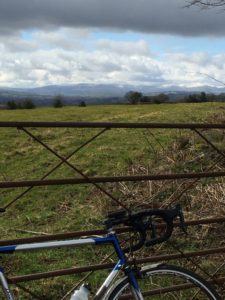How to get ahead in winter
How to get ahead in winter
First of a series of blogs on the new-look website.
The risks you run as a cyclist if you don’t take winter seriously were brought home this week when a cyclist of my acquaintance ventured out on what looked like a decent enough day only to be caught in a big sleet shower 30 miles from base. The bike rider in question had a cape with him but otherwise was in thin stuff. He ended up shivering under a blanket in a cafe, borderline hypothermic; if he had one thing to be thankful for, it was that he didn’t get a mechanical and end up by the roadside at what could have been a very nasty moment.

Over the years I’ve had enough “episodes” to fill up a Monty Python type “we had it tough” sketch – frozen bottles, frozen everything I guess – but the fact is I actually relish the arrival of winter, having worked out some simple ground rules from experience. Some of these are pretty obvious, maybe all of them if you have been cycling for a while. Some you won’t agree with, but that’s fine. I would just add the proviso that these are my own opinions; no one has given me freebies to make me write nice things about their products (interestingly, companies are always happy to give journalists summer kit, never winter stuff).
Tyres. Another cycling friend and I laugh when we recall the “five puncture day,” when said friend had a string of flat tyres en route to the back of beyond; aged 15 or so, he was bailed out each time by the day’s run leader. The reason was simple: his tyres were lousy. So that’s the first thing to invest in: strong, big-section covers. A good trick is to take a third cover with you – fix it with a toe-strap (remember those?) to the seat tube if need be – so that you don’t waste time and risk a second flat looking for that elusive thorn or flint.
Pump. That diddly micro pump is fine for mellow summer evenings, but in winter you want rapid inflation; the less time you stand in the cold the better. So if carbon dioxide capsules are your thing, don’t stint; if not, I promise you won’t regret investing in a decent length pump with capacity enough to get tyres up fast.
Mudguards. I love them. Others don’t. All I will say is that in winter the true enemy is not the cold, but the wet. You can tolerate low temperatures, but what kills is being soaked and cold. Guards with proper flaps keep you and your riding companions much, much drier, so pushing out a watt or two extra has to be worth the sacrifice. There is a safety argument as well, when group riding, as the crap and wet you throw around in normal British winter conditions makes it hard for anyone on your wheel to see properly.
Carrier. Controversial I know but these aren’t just for cycle tourists. Fit a carrier, and you aren’t limited by the capacity of your jersey pockets which should be filled with the obvious stuff: you can add on a dry undervest to pull on at a cafe stop or a dry pair of gloves which will seem like a life-saver on a wet day. Not to mention that spare cover… Extra weight? Well, the race bike will seem all the lighter come March.
Bike. It was Robert Millar who turned me onto the idea of a specifically built winter bike, 25 years ago. His point was that you will spend more time on your winter bike than any other, so you might as well invest in it; he was the only pro I have known to commission a non team issue bike off his own bat, specially made to take mudguards and big tyres. In Britain, “winter” – taken as the time when the weather and road conditions mean you really don’t want to take your race bike out – can last from October to May, so the point stands. Also, if you’ve put some cash into your winter bike – rather than it just being whatever you have lying around the garage – you are more likely to look after it. And that’s key: washing that winter bike matters, because that is when you spot the bulging tyre or the stone in the brake block eroding the braking surface which might muck up your next ride.
Planning. Sean Kelly’s old maxim is that you don’t know how cold it is until you are on the road has some truth but that needn’t stop you being an obsessive weather watcher. The virtues speak for themselves. Configuring your route so you come back with a tailwind when you are tired and sweaty is common sense due to the temperature drop you get going into a breeze. There’s a serious (some might say slightly sad) satisfaction to be gained from timing your ride so that as you enter the final mile, the heavy rain that has threatened all morning finally gets going; you’ve put one over the weather gods. And when it comes to planning, think about next winter when spring comes; you will find seriously nice expensive winter kit being cleared at keen prices if you are lucky. That half-price jersey or overshoes won’t lose an iota of quality over the summer…
And finally, look for variety. Part of the point of those big tyres and large clearance mudguards is that you can explore the roads and bridleways you might otherwise avoid as too muddy, narrow, poorly surfaced etc for that precious race bike, and which somehow there’s never time for when the weather is nice. Use winter to go away from your normal routes: you won’t regret it.

